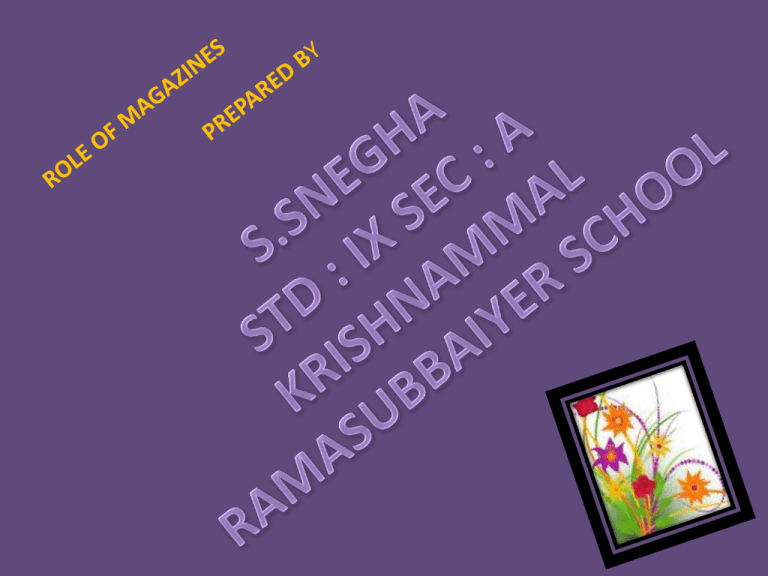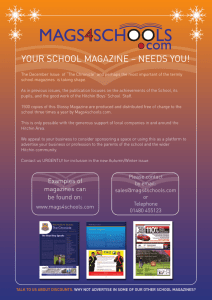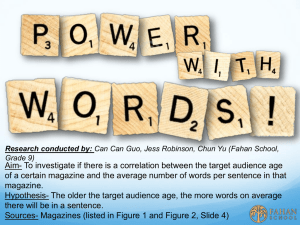MEANS OF COMMUNICATIONS NEWSPAPERS & MAGAZINES
advertisement

INTRODUCTION Magazines are a kind of periodical (along with newspapers), meaning they are published regularly. Common schedules include weekly, biweekly (every other week), monthly, bimonthly (every other month), quarterly, or even annually. Magazines are distributed in several ways. Magazine issues can be sold individually on the newsstand, including grocery stores. They can also be sold as a subscription where several issues will be delivered by mail for a set fee. Magazines are good for advertisers, because they typically cater to a narrow demographic. Since it is easy to discern the audience of most magazines, it makes it easy for advertisers to "target" their ads. Generally, magazine readers are professionals in management, and have higher incomes compared to other media audiences. People pay more attention to magazine advertisements than advertising in any other medium, such as TV, radio, or digital. Chart Of 12 Key Periods in the History of Magazines 1741 First Magazine Published in America 1800 Rapid magazine growth due to increased literacy and decline in postage rates for magazines 1893 McLure's magazine starts "muckraking" in mass circulation magazines 1922 Time becomes first weekly newsmagazine 1936 Life becomes first picture magazine; launches photojournalism 1941-1945 Life graphically documents the progress of World War II with weekly photos 1950 Television results in major drop in magazine ad revenue and circulation 1969 Saturday Evening Post, which was one of the first and most successful general int rest magazines, ceases publication 1970 Specialized magazines start a boom in niche magazines that continues today 1972 Life magazine stops publication as a monthly; Ms magazine launched 1990 Magazines begin publishing on the Internet 2000 Zines (Internet magazines) published by thousands of home-based publishers MEANS OF COMMUNICATIONS NEWSPAPERS & MAGAZINES Firstly, newspapers and magazines supply us with a variety of news every day. They keep us informed of the political situation of the world. By reading newspapers and magazines we can know what is happening in our country as well as in the world at large. Secondly, News papers and magazines contribute a great deal to the development of our knowledge. Through valuable and subtle critical and commentary articles on culture, social civilization, new life style we learn a lot of interesting things. Thanks to newspapers and magazines, our mind and point of view are consolidated and enriched. When reading them we can train our reasoning power. Thirdly, through newspapers and magazines reading, we can find out what we need to know: a job in the situations vacant column, an object we want to buy in the advertising page, a missing relative in the finding missing relative column and condolence news in the agony column Fourthly, the Police Newspapers and Magazines help us take precautious against social evils such as theft, murder, robbery, rape, gambling and smuggling. Fifthly, we can improve our English language by reading newspapers and magazines written in English. This enables us to broaden our knowledge of English in every aspect. DISTRIBUTION :. Three organs consumer trade & professional House organ Role of Magazines Magazine are one of influences in today’s society. the leading In a society when we looks to media like television and magazines to guide our lifestyles and many young women put their lives at serious risk as they strive to look like the stick figures in magazines. Magazines Under Mass & Media Magazines were the first media to become national in scope rather than appealing to a limited geographic area. Literary and commentary magazines flourished in the nineteenth century, and several of them survive today. Magazines for Women , Men, Fashion are through Medias only Trade , MAGAZINES UNDER EDUCATION The role of print media in the process of education is special important. News Papers, Journals & Magazines are means of communication between one source to other. Through Magazines we can learn by Articles, Features, Interviews, Short Stories and we can get very nice literature by magazines. Different types of Magazines having different and versatile knowledge of over all the world MAGAZINES UNDER Health In the face of the growing health care consumerism, accompanied by the proliferation of health-oriented media delivery systems, it is important to explore the audience profile of health magazines. So these magazines may be effectively used for media planning. This paper applies a motivation-driven approach to health magazine readership, arguing that health orientation influences the readership of health magazines. Based on an analysis of the Health styles data gathered in 1999 and building upon selective exposure theory, the study demonstrates that health orientation positively predicts health magazine readership. The study results provide guidelines for strategic media planning. MAGAZINES UNDER TRADE A trade magazine, also called a professional magazine. The magazine published with the intention of target marketing to a specific industry or type of trade The collective term for this area of publishing is the trade press Trade publications are magazines that cover a particular industry rather than being designed for consumers. MAGAZINES UNDER FASHION Fashion magazines have been criticized in recent years for featuring extremely thin models in both ads and editorial content . Critics argue that the unrealistic image promoted by these models can contribute to the development of eating disorders in young women. Several magazines and advertisers have bucked this trend and feature large-sized models and even ordinary people. Other conflicts in the magazine industry include the blurring of editorial content and advertising, and the photos and headlines used on covers Importance of Magazines Magazines in the twenty-first century are continuing many of the trends that made them successful throughout their history, including building relationships with readers, adapting to change, being supported by advertisers, and defining major issues in society. Magazines continue to be successful in their print formats but are expanding their content with Web sites and other electronic offerings.



